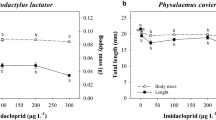Water-borne herbicide threatens amphibian populations in parts of the United States.
Abstract
Atrazine is the most commonly used herbicide in the United States and probably in the world1. Here we investigate the effects of exposure to water-borne atrazine contamination on wild leopard frogs (Rana pipiens) in different regions of the United States and find that 10–92% of males show gonadal abnormalities such as retarded development and hermaphroditism. These results are supported by laboratory observations, which together highlight concerns over the biological effects of environmental atrazine on amphibians.
This is a preview of subscription content, access via your institution
Access options
Subscribe to this journal
Receive 51 print issues and online access
$199.00 per year
only $3.90 per issue
Buy this article
- Purchase on Springer Link
- Instant access to full article PDF
Prices may be subject to local taxes which are calculated during checkout


Similar content being viewed by others
References
US Environmental Protection Agency. Federal Register 59, 60412–60443 (1994).
Akingbemi, B. T. & Hardy, M. P. Ann. Med. 33, 391–403 (2001).
Hayes, T. B. et al. Proc. Natl Acad. Sci. USA 99, 5476–5480 (2002).
Tevera-Mendoza, L. et al. Environ. Toxicol. Chem. 21, 527–531 (2002).
Reeder, A. L. et al. Environ. Health Perspect. 106, 261–266 (1998).
Sanderson, J. T., Letcher, R. J., Heneweer, M., Giesy, J. P. & van den Berg, M. Environ. Health Perspect. 109, 1027–1031 (2001).
Crain, D. A., Guillette, L. J. Jr, Rooney, A. A. & Pickford, D. B. Environ. Health Perspect. 105, 528–533 (1997).
Sanderson, J. T., Seinen, W., Giesy, J. P. & van den Berg, M. Toxicol. Sci. 54, 121–127 (2000).
Kimbrough, R. A. & Litke, D. W. Pesticides in Surface Water in Agricultural and Urban Areas of the South Platte River Basin from Denver, Colorado to North Platte, Nebraska, 1993–94 (NAWQA Program, South Platte River Basin Study, Denver, Colorado, 1995).
Wake, D. B. Science 253, 860 (1991).
Battaglin, W. A. & Goolsby, D. A. Water-Resources Invest. Rep. 94–4176 (US Geol. Surv., Denver, Colorado, 1995).
Stebbins, R. A Field Guide to Western Reptiles and Amphibians: Field Marks of All Species in Western North America, Including Baja California (Houghton–Mifflin, Boston, 1985).
Conant, R. A Field Guide to Reptiles and Amphibians: Eastern and Central North America (Houghton–Mifflin, Boston, 1998).
Author information
Authors and Affiliations
Corresponding author
Ethics declarations
Competing interests
The authors declare no competing financial interests.
Rights and permissions
About this article
Cite this article
Hayes, T., Haston, K., Tsui, M. et al. Feminization of male frogs in the wild. Nature 419, 895–896 (2002). https://doi.org/10.1038/419895a
Issue Date:
DOI: https://doi.org/10.1038/419895a
This article is cited by
-
Roles of Rice Paddies and Neighboring Biotopes with Different Hydroperiods in Providing Habitat for an Endangered Pond Frog Population in Japan
Wetlands (2024)
-
Enhanced removal of estrogens from simulated wastewater by biochar supported nanoscale zero-valent iron: performance and mechanism
Biochar (2023)
-
The Effects of Ditch Management in Agroecosystems on Embryonic and Tadpole Survival, Growth, and Development of Northern Leopard Frogs (Lithobates pipiens)
Archives of Environmental Contamination and Toxicology (2021)
-
The impact of prolonged frozen storage on the preparation quality of bird skins and skeletons in zoological collections
The Science of Nature (2021)
-
Unintended effects of the herbicides 2,4-D and dicamba on lady beetles
Ecotoxicology (2016)
Comments
By submitting a comment you agree to abide by our Terms and Community Guidelines. If you find something abusive or that does not comply with our terms or guidelines please flag it as inappropriate.



